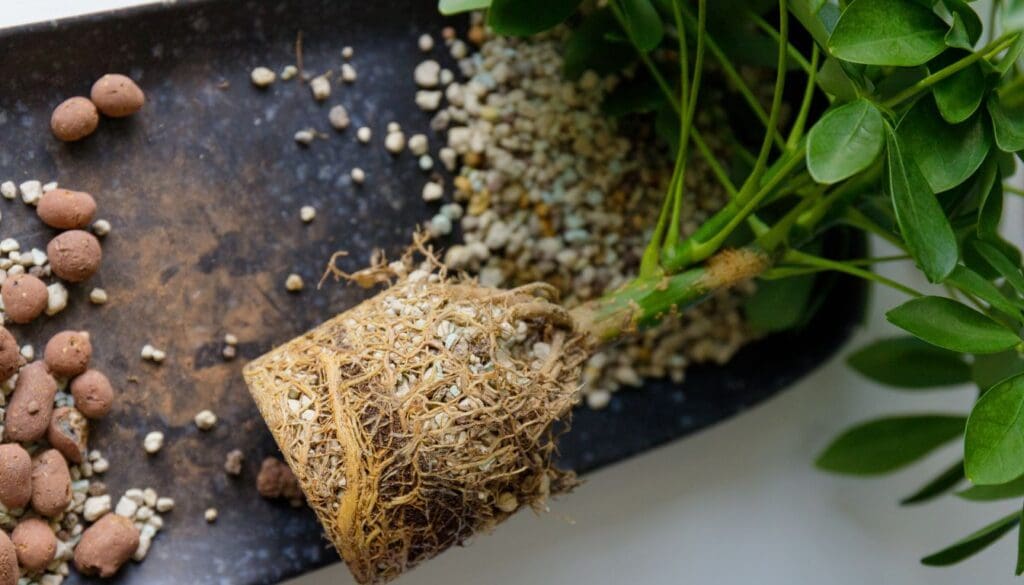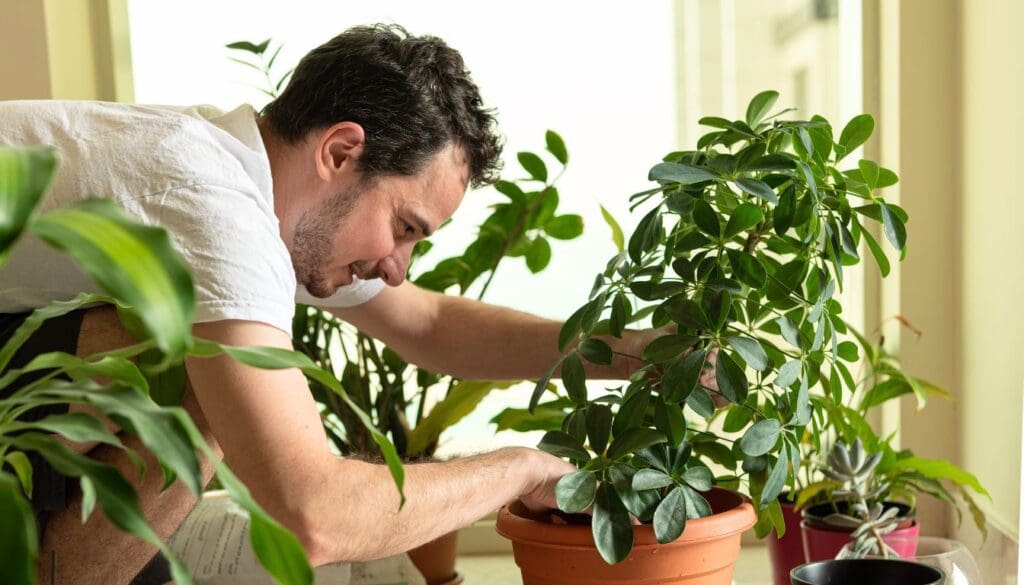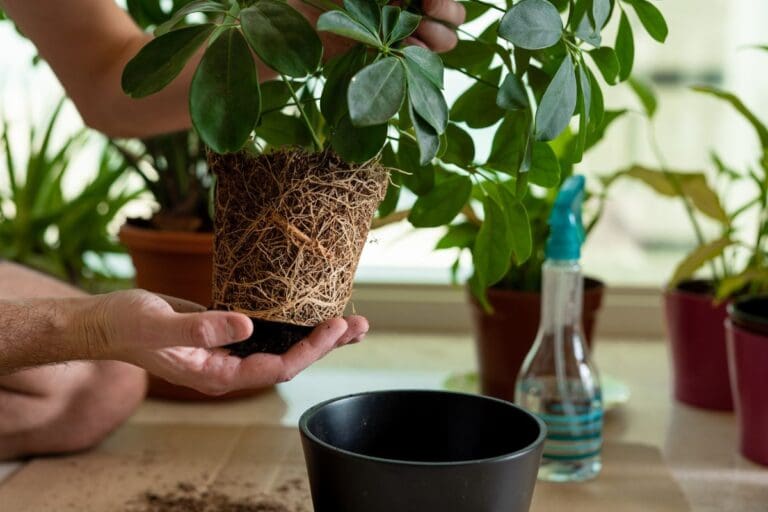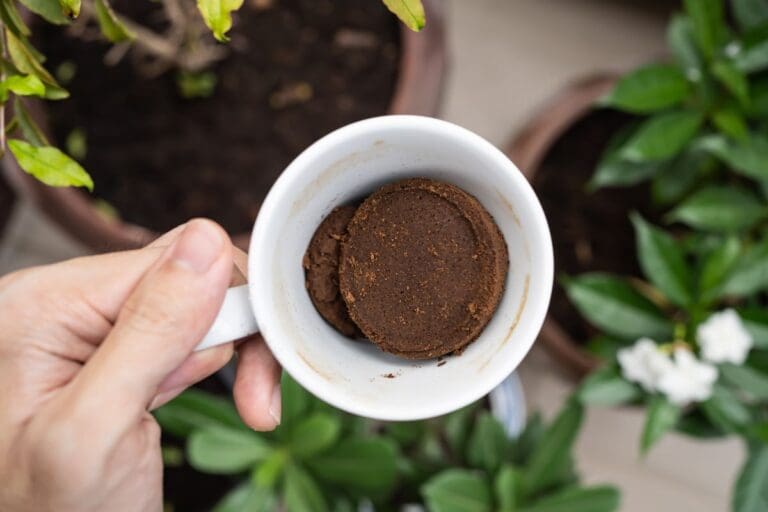Root Rot In Schefflera: Signs, Causes & How To Fix
Schefflera plants are one of the easiest to grow and low-maintenance houseplants. It can tolerate a lot of neglect, including underwatering. However, one of the most dangerous and common reasons that kill this plant is root rot.
Root rot in Schefflera is caused by overwatering, where the roots suffocate due to a lack of oxygen and airflow. Other reasons include poor drainage and heavy soil mix. To fix root rot in Schefflera, prune off the decayed roots, repot the plant in fresh soil, and fix the watering practice.
Let us discuss in this article the various signs of root rot in your plant, understand the causes that lead to this disease, and suggest remedies to fix this problem.

Please note: Simplify Plants is reader-supported. Some links in the post are affiliate links and I get a commission from purchases made through links in the post.
What is root rot?
Root rot is a type of disease that attacks the root of plants and makes them decay, which starts spreading to the plant’s entire body, gradually leading to its death.
It is one of the leading reasons for the death of houseplants if it is left unnoticed.
Multiple reasons lead to the rotting of the roots, among which overwatering is the most common.
This condition is created due to excessively wet and soggy soil, which becomes the breeding ground for the growth of fungus that starts to damage the plant.
When the soil is dry, and the conditions are ideal, these pathogens remain dormant without causing any problem, but these bacteria become active when the soil remains soggy without drying.
In this condition, the naturally white healthy roots begin to rot and get brown and black, which then spreads to the whole body of the plant.
It is of utmost importance that you treat root rot as soon as possible, or you can end up losing the plant.
What are the signs of root rot in Schefflera?
Root rot is not easy to notice in the initial stages because the problem begins under the soil surface, which remains absent to our eyes.
We only start to notice it once the rotting starts to spread in the plant’s body and shows signs like wilting, yellowing, etc.
The moment you notice these signs, you must take action to save the plant.
Now we will discuss the different signs that your Schefflera plant starts to exhibit if there is root rot.
Discolored leaves

Root rot causes the discoloration of leaves in your Schefflera.
The umbrella plant generally has green leaves.
Yellowing of leaves is a natural phenomenon for aging, so mature leaves get yellow and fall off.
However, if you notice many of the leaves are turning yellow and brown, it is not natural and is a sign that the plant is in crisis.
Foul smell from the soil
As the roots begin to decay due to not getting oxygen and air, they rot, emitting an odor.
The fungus that thrives in the anaerobic condition begins to consume the roots, and as the rot progresses, a foul smell comes from the soil.
You must not ignore this condition and check the roots.
Stagnant growth
Schefflera plants are fairly fast-growing and remain healthy if given the ideal conditions.
However, if you notice your plant has suddenly stopped growing and is no more pushing out new growth, it might be a sign of root rot.
Root rot weakens the plant’s root system, which is the main organ that helps the plant get nutrients and grow.
So without sufficient food and a weak body, the plant’s growth stops.
Wilted leaves

A common sign of root rot is wilting of the foliage.
As root rot progresses, the root system gets weaker and fails to absorb sufficient nutrients and moisture from the soil.
This begins to wilt the plant as it no more has the energy to grow.
Wilting of the plant signifies an advanced level of root rot, so if you notice this symptom, you must immediately check the roots.
Rotten mushy roots
The roots of a healthy, thriving Schefflera are white, fresh, and crisp.
But if the plant is undergoing root rot, the roots begin to get brown or black and mushy and rotten.
They lose their crisp texture and become soft, emitting a foul odor.
If you notice such a condition, you must never delay and take action to treat this problem.
Also read: How to get rid of the smell in potting soil?
What are the causes of root rot in Schefflera?
In the above section, we have discussed all the signs that your umbrella plant begins exhibiting if root rot pathogens attack it.
Let us now discuss the various reasons for your Schefflera undergoing a root rot problem.
Overwatering

The most common cause of root rot in your umbrella plant is overwatering.
Schefflera plants are prone to be overwatered, and it is one of the most common reasons that kill them.
Overwatering happens when you water your plant more than required, so the plant fails to get rid of the excess water.
The soil becomes soggy, and the roots fail to dry out, which becomes a barrier to the healthy flow of air in the soil.
The waterlogged soil fails to support the plant with nutrients and oxygen, thereby suffocating the roots.
Schefflera plants like loose and well-draining soil, and if the roots are exposed to the soggy condition for too long, they start decaying.
Your umbrella plant is more prone to overwatering during monsoons and winters when the evaporation rates are low, and you must reduce the watering pattern during these seasons.
Also read: How Much Water Does A Schefflera Plant Need? (Watering Guide)
Poor drainage in the pot
A pot with a good drainage system plays an important role in preventing root rotting.
Root rot occurs when the excess water cannot escape and instead stays locked inside the pot.
The pot you choose to grow your Schefflera should have drainage holes at the bottom, which lets the excess water flow out of the pot.
Many plant growers use decorative pots that add visual beauty to the indoor garden but have no drainage holes.
This traps the excess water, and the soil does not get a chance to dry and remains soggy and wet, which becomes the breeding ground for diseases and fungus.
Also read: What Kind Of Pot Do You Use For Schefflera? (Size, Material & More)
Wrong soil
Schefflera plants require loamy soil that is loose and well-draining to let air flow in the soil.
If the soil you use for your plant is too tight and compact and is clayey instead of loamy, it will trap the excess water in the soil.
Such compact soil does not let airflow and air circulation in the soil.
This creates an unsuitable environment for the plant roots to breathe, leading to the growth of pathogens in the roots.
Also read: What Kind Of Soil Does A Schefflera Plant Need? (+Ideal DIY Soil Mix)
Incorrect pot material

Along with the size of the pot, the material of the pot plays an important role too.
Plastic, ceramic, and metal pots are non-porous and do not let air flow in them.
This lets the soil stay wet for a longer period.
Clay and terracotta pots are highly recommended because they are porous, and the chances of root rot in them are low because the soil dries out fast.
Wrong pot size
A pot that is too big for your Schefflera can be very harmful to your plant and can lead to overwatering and eventually root rot.
A pot that is too big compared to the plant holds more soil than required.
So this soil retains excess water keeping the soil wet for a long time.
As the plant cannot absorb all the water, this creates overwatering issues in the soil.
Also read: What happens when you put a plant in too big of a pot?
Not emptying cache tray
Another mistake we commonly make that leads to root rot is that we often forget to empty the trays that hold the water that seep out from the drainage holes.
This water keeps the bottom of the pot wet, which keeps the soil soggy, resulting in root rot.
Low temperatures

Schefflera plants thrive in temperatures ranging between 65°F to 90°F.
When the temperature goes below this range, the plant finds it hard to grow because they are tropical, warm-loving plants and cannot tolerate extreme cold.
Extreme cold in winters pushes the plant to dormancy.
In such weather, the cold temperature lowers the evaporation of the excess water from the soil.
So the soil remains wet for a long time, and if watering is not cut during this season, root rot occurs.
Also read: Schefflera Plant Temperature Tolerance: Ideal Temperature+Problems
Low light
Low light conditions also lead to overwatering and root rot issues because the soil takes a long time to dry out in low-light environments.
Low light also reduces the plant’s photosynthesis level, making the plant less active, thus reducing its water absorption rate.
This environment creates an ideal condition for the growth of fungus in the soil.
Also read: What Kind Of Light Does A Schefflera Need?
Poor ventilation around the plant
Every houseplant requires sufficient ventilation for healthy growth.
Poor airflow around the plant does not let the soil dry out and keeps it soggy for a long time, leading to root rot problems.
This situation occurs when we keep our plants too closely grouped or keep them in a corner where there is not much airflow.
Infected tools
Sometimes root rot also spreads from infected and contaminated gardening tools.
If we use tools contaminated by fungus, it can spread to a healthy plant causing root rot.
This is why we must always disinfect the tools before and after usage.
Buying an already sick plant
Sometimes we also buy an infected plant from the market, so it is important to inspect the plant thoroughly before buying.
Overfertilization

Schefflera plants are light feeders, and over-fertilizing them burns the plant’s roots.
This causes a lot of stress to the roots, which can often lead to root rot.
You should avoid fertilizing them in winters as they remain dormant and the roots fail to absorb the fertilizer leading to stress and root rot.
How do you fix root rot in umbrella plants?
Now that we have understood the various causes of root rot in your Schefflera and its signs to convey the problem let us quickly jump into the cure to fix it.
Since root rot affects the plant’s roots, the only solution or cure to this problem is clearing out the rot from the roots, and the only way to do that is by trimming off the roots and repotting them in fresh soil.
However, you have to know that you can cure root rot if it is in the initial stages.
If the root rot advances to the entire plant and is not stopped in time, it might get difficult to save the Schefflera, and even repotting might not help.
Let us now look at the steps of repotting your Schefflera to fix the repotting disease.
1. Take the plant out
The first step to reaching the roots is taking the plant out of the pot.
Turn the pot upside down gently and bring out the plant from the pot.
If it is stuck inside and refuses to come out, gently scrape the sides of the pot to bring out the plant with a knife.
This is the first and crucial step because if you pull out the plant with force, it can damage the plant badly, which will be disastrous for the already stressed plant.
2. Inspect the roots
Once the plant is out of the pot, check the roots carefully.
Wash the roots under running water to get rid of all the dirt and make it easier to distinguish between the rotten and the healthy roots.
After cleaning the roots, you will find out which roots are to prune off.
3. Prepare to prune

Next, sterilize your sharp pruning shears well and wear gloves to protect your hand from the harmful sap of the Schefflera containing calcium oxalate crystals which may cause skin irritation.
4. Start pruning the mushy roots
The most important part of the cure is to prune off the damaged roots so that the infestation does not spread further.
To begin this, start trimming away the mushy, brown, and black leaves keeping the fresh white roots intact.
5. Trim the infected leaves and parts of the plant
Once the roots have been cleared, it is time to cut back the damaged parts of the plant’s body, this help to reduce the stress on the already stressed plants.
Sterilize your pruners and start cutting the plant’s yellow or brown leaves or branches.
Remember not to prune more than 25% of the leaves, affecting their photosynthesize capacity.
6. Disinfect the pot
Once you are done with the pruning, it is time to repot the plant in fresh soil.
It is best to use a new fresh pot; however, cleaning the existing pot is important if you do not have a new one.
For this, wash it under running water and soak it in bleach solution for 15 minutes to kill all the fungus and pathogens attached.
Prepare the above solution by mixing 20% bleach with 80% water.
7. Apply a fungicide
Before repotting the plant, killing all the fungus that might still be attached to the plant is important.
For this:
- Mix half a tablespoon of fungicides like cinnamon, hydrogen peroxide, or chamomile in a bucket of water.
- Dip the root ball of the plant in this solution for 10 minutes
- Take the plant out and keep it in bright light to dry up.
8. Repot
Now prepare a light soil mix for your Schefflera.
Add sand, perlite, and compost to the soil and mix it well.
Now take the pot and begin the repotting:
- Fill the pot with a soil layer at the end and gently press it.
- Take the Schefflera, put it in the center of the pot, and pour soil from all the sides.
- Fill the pot to the pot’s rim, leaving some space at the top.
- Spread the soil equally and press it gently to ensure no air gaps.
- Water the plant thoroughly until it runs out of the drainage holes.
9. Provide ideal conditions to the plant
Repotting an already stressed plant puts a lot of added stress on the plant, so it is of utmost importance that you provide the perfect growing conditions for the plant.
Put the plant at a spot that gets bright indirect light and good airflow and does not disturb the plant after repotting.
Water it only when you see the topsoil getting dry.
Do not fertilize the plant again after repotting as the soil already has compost.
10. Observe the plant
Once you have repotted the Schefflera, keep an eye on its health.
It might look droopy and sick for a few days, but it will bounce back in 4-5 days if it gets in the right condition.
How to prevent root rot in Schefflera?

To prevent your plant from getting root rot again, you must follow some steps.
Let us look at them:
- Water the plant only when the soil is dry. If you find it difficult to understand, then dip your finger in the soil to check whether it sticks to your finger or not. You can also use a moisture meter.
- Always empty the cache or trays below the pot after watering your plants.
- Keep the plant in an area with bright but indirect light. Do not keep it in a low-light area. If you do, make sure to water accordingly.
- Make sure the spot has good air circulation around it.
- Prepare a good quality, light, well-draining potting mix for your umbrella plant.
- Do not use a pot that is too big for your Schefflera.
- Fertilize your Schefflera plant in the growing seasons with 20:20:20 balanced NPK fertilizer or compost.
- Give humidity to your plant with the help of a humidifier.
- Protect the plant from extreme cold or hot temperatures.
- Always sterilize your gardening equipment before and after use.
Final words
Root rot is a deadly condition that can kill your umbrella plant if you don’t notice it on time and don’t fix it. It is best to avoid root rot, as it is not easy to deal with it.
Avoid overwatering, let the plant have enough light, provide proper ventilation and drainage system, and take care of the basic requirements of the plant.
Don’t panic if your umbrella plant has root rot. Try removing the affected roots and repotting the plant. If all the roots are damaged, discard the plant and try propagating it if you find a healthy stalk.
Reference: Wikipedia, Sciencedirect, Britannica, American Society for Horticultural Science, Schefflera taxonomic history.
Recommended Garden Supplies
| Product Image | Our Recommended Gardening Supplies | Check Offers! |
|---|---|---|
Top Top
Top
Top
Top
Top
Top
Top
Top | rePotme Houseplant and Tropical Classic Potting Soil Mix | Check Offer On Amazon |
 Top
Top
Top
Top
Top
Top
Top
Top | Espoma Organic Indoor Plant Food | Check Offer On Amazon |
 Top
Top
Top
Top
Top
Top
Top
Top | GooingTop LED Grow Light 6000K Full Spectrum Clip Plant Growing Lamp | Check Offer On Amazon |
 Top
Top
Top
Top
Top
Top
Top
Top | Soil Moisture Meter | Check Offer On Amazon |
 Top
Top
Top
Top
Top
Top
Top
Top | Govee Hygrometer Thermometer, Bluetooth Enabled! | Check Offer On Amazon |
 Top
Top | LEVOIT Humidifiers for Large Room(Best For Plants) | Check Offer On Amazon |
 Top
Top
Top
Top
Top
Top
Top
Top | Upgraded DIY Automatic Drip Irrigation Kit, 15 Potted Houseplants Support | Check Offer On Amazon |
 Top
Top
Top
Top
Top
Top
Top
Top | Stainless Steel Heavy Duty Gardening Tool Set | Check Offer On Amazon |
 Top
Top
Top
Top
Top
Top
Top
Top | Bonide Insecticidal Soap | Check Offer On Amazon |
 Top
Top
Top
Top
Top
Top
Top
Top | Bonide 32 oz Spray Neem Oil for Organic Gardening | Check Offer On Amazon |
 Top
Top
Top
Top
Top
Top
Top
Top | Garden Safe Fungicide | Check Offer On Amazon |








